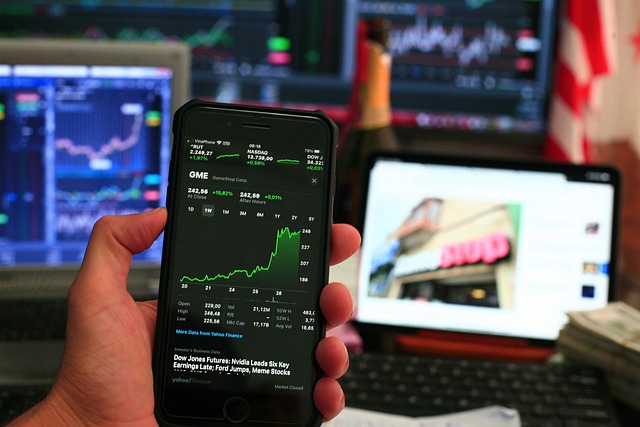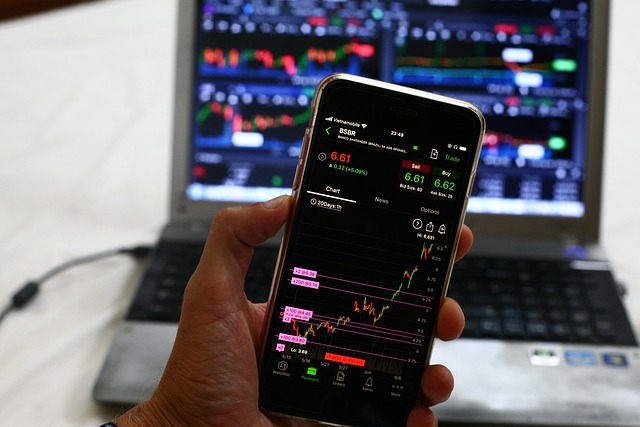Top AI Apps for Stock Market India: Tools, Use-Cases & 2025 Trends
Author: Jameson Richman Expert
Published On: 2025-10-31
Prepared by Jameson Richman and our team of experts with over a decade of experience in cryptocurrency and digital asset analysis. Learn more about us.
AI apps for stock market India are rapidly changing how retail and professional traders discover ideas, manage risk, and automate execution. This article explains what these apps do, highlights leading features and use-cases, gives practical advice for choosing and evaluating tools, covers regulatory and data considerations specific to India, and points to resources and platforms to get started. Whether you want AI-driven trade signals, sentiment analysis, portfolio optimization, or to build your own model, this in-depth guide will help you navigate the ecosystem and avoid common pitfalls.

Why AI matters for the Indian stock market
Artificial intelligence and machine learning (ML) are not magic — they are advanced statistical models and automation frameworks that extract patterns from data and turn them into actionable signals. In India, the combination of rapidly growing retail participation, increasing access to market data, and low-latency broker APIs has created fertile ground for AI-driven apps. Advantages include:
- Pattern recognition: Detect cyclical behavior or relationships across stocks that human traders might miss.
- Faster processing: Real-time scanning of thousands of tickers and indicators to generate trade ideas.
- Automation: Execute strategies with minimal emotional bias and improved discipline.
- Personalization: Models can be tuned to risk appetite, investment horizon, and capital.
That said, AI apps are tools — not guaranteed profit machines. Successful use requires sound data, realistic backtesting, robust risk management, and regulatory awareness.
Common types of AI apps for stock market India
AI apps for the Indian market typically fall into several categories. Understanding these helps you pick the right tool for your needs.
- Forecasting & price prediction: Time-series models (LSTM, Transformer-based) or ensemble methods that predict short-term price movements.
- Signal generation & trade recommendations: Systems that convert model outputs to buy/sell/hold signals, often with probability scores.
- Sentiment analysis: NLP models that score news, analyst reports, and social media for bullish/bearish sentiment relevant to Indian tickers.
- Portfolio optimization & allocation: AI for risk parity, mean-variance optimization with ML-based expected returns and covariance estimation.
- Algorithmic execution: Automated order routing and execution strategies (TWAP, VWAP) with ML-driven slippage predictions.
- Backtesting & walk-forward testing platforms: Tools that combine ML model evaluation with robust backtesting frameworks.
- Advisory & robo-advisors: AI-driven advisory apps for long-term investors (goal-based recommendations, rebalancing).
Top features to look for in AI stock market apps (India)
When evaluating apps, prioritize quality of data, model transparency, risk controls, and execution capabilities. Here's a checklist:
- Data sources and latency — Does the app use reliable Indian exchanges data (NSE, BSE)? Is tick-level or end-of-day data available? For intraday trading, low-latency data is essential (see NSE data portal: NSE India).
- Backtesting rigor — Look for walk-forward testing, realistic transaction costs, slippage modeling, and out-of-sample evaluation.
- Explainability — Are predictions accompanied by feature importance or rationale? Black-box models without context are risky.
- Risk controls — Position sizing rules, max drawdown limits, stop-loss mechanisms and stress-testing scenarios.
- Broker integration — Seamless connectivity to Indian brokers (API support, order types); or support for global exchanges if you trade derivatives or crypto alongside stocks.
- User interface & alerting — Clear dashboards, notifications (SMS/Telegram/email) and mobile app functionality.
- Security & compliance — Data encryption, secure OAuth/API key management, and adherence to local regulations (SEBI guidance).

Examples of AI-driven features and how traders use them
Below are practical features AI apps provide and examples of how traders can use them in India.
1. Short-term price movement prediction
AI models can forecast next-hour or next-day returns using features like price history, volume patterns, implied volatility from options, and order book depth. A common approach combines technical indicators (RSI, MACD) with an LSTM or gradient boosting model. Use-case: generate intraday trading signals with probability thresholds and trade only when model confidence exceeds 70%.
2. Sentiment-based signals
NLP models process news articles, regulatory filings, and social media (Twitter/X, StockTwits, Reddit) for sentiment scores. For India, local-language sentiment (Hindi, regional languages) is an emerging frontier. Use-case: avoid earnings-related trades with negative sentiment trending or identify momentum plays after high positive sentiment spikes.
3. Pair trading & statistical arbitrage
AI helps identify co-integrated pairs among Indian equities, ETFs or cross-asset pairs (equity vs futures). Models monitor spread deviations and use machine learning to adjust entry/exit thresholds dynamically.
4. Portfolio allocation & rebalancing
Robo-advisors and portfolio tools use ML to estimate expected returns and covariances for periodic rebalancing. Use-case: dynamically adjust equity allocation based on market regime classification (bull/bear/sideways) inferred by unsupervised learning.
Practical examples and simple strategy blueprints
Below are approachable examples you can test with historical data before risking capital.
Example A — ML-enhanced momentum strategy (daily)
- Universe: Top 200 stocks by average daily volume on NSE.
- Features: 1, 7, 30-day returns; 14-day RSI; 20-day volatility; volume surge metric.
- Model: Gradient boosting classifier predicts probability of positive next-day return.
- Rule: Buy next-day at open if probability > 0.6; position size based on Kelly fraction with cap at 2% account value.
- Risk: Apply stop-loss at 3% and trailing stop at 5%.
Example B — News-sentiment volatility filter (swing trades)
- Scan news for universe using sentiment model; flag high positive or negative sentiment above z-score 2.
- Combine with volatility breakout (price above 20-day high) to take momentum trades.
- Exit: revert-to-mean signals or fixed calendar horizon (3–7 days).
Both examples should be backtested with transaction costs, slippage and realistic fill assumptions before execution.
How to evaluate performance: metrics and best practices
Valid evaluation is crucial to separate effective AI apps from overfitted models.
- Out-of-sample testing: Reserve a time-based test set — do not mix future data into training.
- Walk-forward analysis: Re-train models on rolling windows to simulate real-world deployment.
- Transaction costs & slippage: Include brokerage fees, taxes (STT/SEBI charges), and realistic slippage especially for illiquid stocks.
- Stability metrics: Monitor rolling Sharpe, max drawdown, monthly hit-rate to detect performance decay.
- Model drift monitoring: Track feature distributions and model confidence over time; set triggers to retrain.

Regulatory and data considerations in India
Using AI in the Indian markets requires awareness of local rules and data licensing:
- SEBI oversight: The Securities and Exchange Board of India regulates market participants. For algorithmic trading and order routing, institutional participants need necessary approvals and compliance systems. Retail traders using broker APIs should ensure their activity complies with broker terms and SEBI guidelines (SEBI).
- Data licensing: Market data from NSE and BSE may have licensing restrictions for redistribution. Verify whether an AI app has appropriate data licenses before relying on it for commercial use.
- Record keeping & surveillance: Exchanges require trade logs and audit trails; automated systems must preserve detailed logs to assist compliance checks.
Where to get high-quality Indian market data
Reliable data is the lifeblood of AI models. Sources include:
- NSE & BSE official portals: End-of-day and historical data from exchanges (NSE, BSE).
- Broker APIs: Zerodha Kite, Upstox, etc., provide live feeds and historical data for account holders (see broker API pages for details).
- Commercial vendors: Refinitiv, Bloomberg, TickData for institutional-grade data.
- Open sources: Yahoo Finance and Alpha Vantage (global tickers) can be useful for prototyping but check data gaps and accuracy.
Popular AI-driven apps and platforms used by Indian traders
There are both India-focused apps and global platforms that Indian traders use via APIs. Examples of capabilities to look for rather than exhaustive endorsements:
- Platforms that combine ML signal generation with broker execution and mobile alerts.
- Backtesting frameworks that allow Python or R users to plug models and run walk-forward tests.
- Sentiment dashboards that aggregate Indian news and social media.
To dive deeper into app validation and how to check credibility of trading apps, see this comprehensive review and verification guide: Trader App Reviews — Ultimate Verification Guide.

Integrating AI apps with brokers and exchanges
To execute AI-generated ideas you need broker integration. Many Indian traders use local brokers for equities and global crypto/derivatives exchanges for alternate exposure. Popular exchanges and sign-up resources (useful for traders exploring both crypto and cross-asset strategies):
- Register for Binance — large global exchange (supports APIs for algorithmic trading).
- Register for MEXC — another exchange with API support.
- Register for Bitget — API-enabled exchange.
- Register for Bybit — widely used for derivatives strategies.
For Indian equities, connect to brokers with robust APIs (e.g., Zerodha Kite, Upstox). When integrating, test in paper-trading mode, verify order types, and confirm latency and fill assumptions.
Building your own AI app: stack, tools and datasets
Traders building an in-house AI app typically use the following stack:
- Data ingestion: NSE/BSE feeds, broker APIs, news APIs, alternative data (Google Trends, sentiment sources).
- Data storage: Time-series databases (kdb+/kdb, InfluxDB) or cloud storage (S3 + Parquet).
- Modeling: Python ecosystem (pandas, scikit-learn, XGBoost, LightGBM, TensorFlow, PyTorch).
- Backtesting: Backtrader, Zipline, or custom frameworks with walk-forward support.
- Execution: Broker APIs, FIX connectivity for institutional desks, or exchange APIs for crypto derivatives.
- Monitoring: Prometheus/Grafana, model performance dashboards and alerting systems.
Important datasets include cleaned historical OHLCV (open-high-low-close-volume), order book snapshots for HFT strategies, corporate actions, earnings and option chain data. For a primer on average trading volume trends and how they affect strategy design, see this analysis on 2025 trading trends: 2025 Trends & Average Daily Trading Volume of Indian Stock Market.
Common pitfalls and how to avoid them
Many traders fall into avoidable traps when adopting AI apps. Here are the most common pitfalls and practical mitigations:
- Overfitting: Use cross-validation, restrict model complexity, and favor simpler models if performance gains are marginal.
- Data snooping bias: Avoid tuning on the test set; use strict time-based splits.
- Poor slippage assumptions: Model fills realistically — larger orders require market impact modeling.
- Neglecting risk management: Always define position sizing, maximum drawdowns, and capital allocation rules before trading live.
- Lack of operational controls: Ensure kill-switches, rate limits, and logging to prevent runaway algorithms.

Case study: Deploying an AI news-sentiment filter for swing trades
Step-by-step example to show how a small team might deploy a live AI app for Indian swing trading.
- Data collection: Aggregate news feeds (Reuters, Economic Times), company filings, and Twitter mentions for Indian tickers.
- Model training: Label sample headlines as positive/neutral/negative; fine-tune a multilingual BERT model for Indian English/Hinglish expressions.
- Signal generation: Combine sentiment signal with 10-day volatility breakout to produce candidate list.
- Backtesting: Test over multiple market regimes (2016–2024) with slippage and transaction cost modeling.
- Deployment: Containerize model as API, connect to broker API for paper trading, and monitor daily P&L and signal quality.
- Governance: Monthly retraining cadence, drift detection and a human-in-the-loop threshold for large position sizes.
This approach balances automated signal generation with human oversight and governance.
Evaluating AI app vendors and marketplaces
When choosing a third-party app or marketplace, assess the following:
- Transparency: Does the vendor publish performance metrics and methodology?
- Reputation & reviews: Search credible review platforms and community forums. Use verification guides like the one linked earlier (Trader App Reviews — Verification Guide).
- Trial & demo: Prefer vendors that offer sandbox environments or paper trading.
- Support & SLAs: For paid plans, check availability of technical support and uptime guarantees.
Education and learning resources
If you are new to algorithmic trading or AI, start with structured courses and materials. For retail traders who also want to learn derivatives and crypto execution, a step-by-step trading course can be helpful; for example, this free complete beginner-to-pro Binance trading course provides practical traction for exchange-based strategies: Binance Trading Full Course.
Other recommended learning resources:
- Algorithmic trading overview: Wikipedia — Algorithmic trading
- Machine learning fundamentals: Andrew Ng’s courses or equivalent university materials.
- Academic papers on financial time-series forecasting and backtesting best practices (search Google Scholar for regime-switching and LSTM in finance).

AI apps and cross-asset strategies (stocks, forex, crypto)
Many AI models generalize across asset classes — techniques used for stock forecasting apply to forex and crypto with dataset and liquidity adjustments. If you are exploring multi-asset approaches, review platform-specific guides. For choosing trading platforms and broker-software combinations (especially if you trade forex or require global broker access), this guide can help: Which Platform is Best for Forex Trading — Complete Guide.
Cost considerations and pricing models
AI apps come with different pricing models:
- Subscription: Monthly/annual fee for signals, dashboards, or SaaS platforms.
- Performance fee: A percentage of profits (common in managed strategies or some marketplaces).
- Commission per trade: Some platforms charge per executed trade on their infrastructure.
- Data & API fees: Additional costs for premium data or high-frequency API access.
Always account for these fees when backtesting: net returns after fees determine real viability.
Security, privacy and ethical considerations
Security is paramount when connecting AI apps to brokerage accounts:
- Use APIs with token-based authentication and never share credentials via email.
- Encrypt stored data and use least-privilege principles for API keys.
- Consider privacy implications of alternative data sources (scraping social media or third-party data may have legal restrictions).
- Ethics: avoid strategies that exploit non-public information or that could be construed as market manipulation.

Monitoring, maintenance and continuous improvement
AI apps require ongoing maintenance:
- Monitor live performance continuously and compare to backtested expectations.
- Detect model drift and schedule retraining based on performance triggers.
- Maintain a feature store and reproducible pipelines so model updates are auditable.
Next steps: How to trial AI apps safely
- Start with a small sandbox or paper account and validate end-to-end workflows.
- Use realistic capital and order sizes during simulation to account for liquidity.
- Set clear acceptance criteria (e.g., Sharpe improvement over baseline, maximum allowed drawdown).
- Gradually scale up once model robustness is proven and monitoring is in place.
Additional resources and reading
For traders who want to dig deeper into market structure and volume trends relevant to AI strategies, review industry analyses and long-form guides. One useful piece on expected 2025 market trends and volume dynamics is available here: 2025 Trends & Average Daily Trading Volume — Indian Market Explained.
If you evaluate third-party trading apps or marketplaces, use verification methods and community feedback; a practical guide is here: Trader App Reviews — Verification Guide. And if you are expanding into exchange-based or multi-asset algorithmic execution, a general platform study and course can be found here: Binance Trading — Complete Beginner-to-Pro Guide.

Conclusion — Are AI apps right for you?
AI apps for stock market India offer compelling tools for idea generation, risk management, and automation. They can improve trade discovery and portfolio construction, but only when paired with high-quality data, robust backtesting, careful risk controls, and continuous monitoring. Start small, validate thoroughly with realistic assumptions, and treat AI as an assistive technology rather than a black-box solution.
For traders looking to broaden their toolkit with exchange accounts or to experiment with cross-asset strategies, consider creating accounts on API-friendly exchanges (Binance, MEXC, Bitget, Bybit) and connecting them to sandbox environments before live trading using the links provided earlier in this guide:
Want help choosing the right AI app or assessing a vendor? Share your trading style, timeframe, and capital, and I can recommend specific platforms and features tailored to your needs.